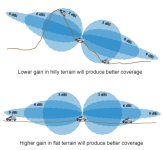From the article that Boris cited:
Power output is often thought to increase range, but really, the difference in range between a 25-watt fixed marine VHF radio and a 5-watt handheld is due to the fixed mount's antenna being taller, and therefore it can "see" farther. More power will allow you to punch through static and other radio traffic better, but only within the range dictated by antenna height. Marine VHF radios work on a line-of-sight basis. That is, they can transmit and receive to and from another antenna as long as that antenna is above the horizon. How far is that? Standing in the cockpit of a boat, the distance to the horizon for most adults is about
Since the line of site to the horizon is about 3 miles--communication between two boats, both at about 6 feet is 6 miles. But when you to to 12 feet off the water, the line to the horizon is about 5 miles, when you have two antenna's each 12 feet off the water, the total range is about 10 miles.
Say your buddy has an antenna mounted atop his large cruiser at 18 feet above sea level. Combined with the 12-foot height of your antenna, the two of you could converse while about 6.7 miles apart.
. That is incorrect: The VHF range will be about 11 miles. The 12 foot antenna is about 5 miles, and the extra 6 feet only gains you a mile, or 6 miles, combine the two--11 miles.
Antennas do not alter the power. 5 watts out is all you get (if that) from a 5 watt radio.
From a ham radio site:
Unity gain (equivalent to 0 dB gain) ¼ wave antennas propagate RF in an omnidirectional, or circular pattern. Since an antenna does not make power, increasing gain in one direction will decrease propagation in another. Typically, antennas with gain will lose the vertical propagation or “roundness” of the pattern and become flattened and elongated with the higher gain antenna you choose. As you can see in the illustration, using a gain antenna may cause poor performance in a hilly environment.
The images below are in ref to a land based vehicle on roads, but equate directly to a rolling boat. If you have a high gain antenna and the boat rolls or heels, you may actually have less of a signal in the direction you want. That is why on sailboats one uses lower gain antennas.

.
Smiley notes for the collapsible antenna:
usable in 2 positions. Fully extended or fully collapsed. It is a true 1/4 wave when collapsed & 5/8 wave when extended
So it is unity (1/4 wave) collapsed, and should be 5/8 wave extended, but here it gets a little dicey: There are other factors: ground plane (base loaded), also the question of impedance (which is a better match at 3/4 wave length)...
When used as a vertical radiator against a ground plane this translates to a length of 5/8 wavelength. It is found that a five eighths wavelength vertical antenna has a gain of close to 4 dBd, i.e. 4 dB gain over a dipole.
To achieve this gain the antenna must be constructed of the right materials so that losses are reduced to the absolute minimum and the overall performance is maintained, otherwise much of the advantage of using the additional length will be lost.
The question is how are you going to measure any improved performance of the radio? It would be of interest to see where the resonate frequencies of the standard and Smiley antennas are? I see that the Simley is made of copper plated steel. It it is not waterproof, how will that hold up? Bring your radio to Hontoon, and we can put an antenna analyzer on it...but the problem may be connection to the SMA Male fitting. Would need a SMA male to BCN or PL 259 fitting. Putting an adaptor in costs about one dB. It would be interesting to do analysis on all of the Smiley antennas--because they have them for Marine 150 to 160, Air: 125 to 132 and 132 to 136, Commercial: 150, 160, 170 (plus a spectrum of the 440 to 460 public service range) and the ham 146.25 "tuned". and the 220 and 440 bands. At that price they are not hand tuning each antenna. I find a fair variation in the off the shelf Shakespeare VHF antennas resonate frequency which are far more expensive; which makes me a bit skeptical. I hope I am proven wrong. There is only. so much one can do with antennas on a small hand held radio, with multiple factors to consider.


